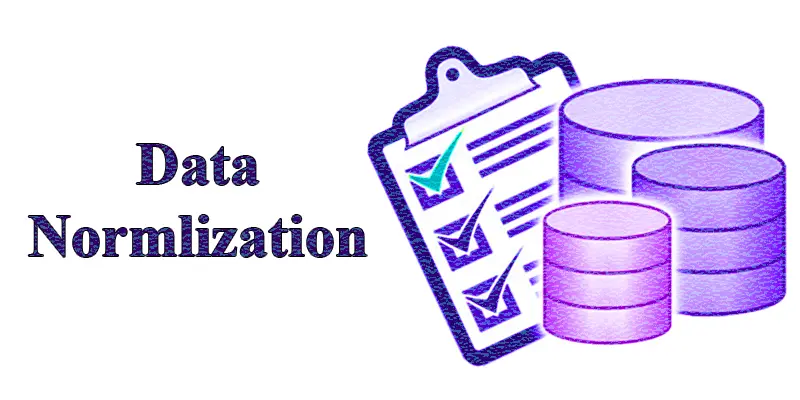Data Normalization Made Easy | Clean & Smart Databases
Published: 17 Jan 2025
Data Normalization
Did you know that messy and unorganized data causes over 70% of database problems? Many people get confused when they hear about data normalization. What is it? Why is it needed? If you’ve ever struggled with duplicate entries, slow queries, or errors in your database, you’re not alone. Data normalization is a clever method to clean up your data, make it more efficient, and maintain the functionality of your system. Just like sorting your books on the shelf, normalization puts your data in the right place.
Data Normalization: What Is It?
The technique of arranging data in a database to minimize duplication and facilitate management is known as data normalization. It helps keep data clean and consistent. Example: Instead of storing a teacher’s name many times in a student table, normalization stores it once in a separate teacher table and links it to students.
Key Objectives of Data Normalization
- Reduce Data Duplication: It stops the same data from being saved multiple times.
- Improve Data Consistency: Ensures all data is accurate and updated in one place.
- Prevent Data Anomalies: Avoids errors when adding, deleting, or updating data.
- Organize Data Efficiently: Breaks large tables into smaller, linked tables for easy management.
Why Do We Use Normalization?
Normalization is important because it helps organize data, reducing problems like redundancy and inconsistency that can arise when storing information in a database. Let’s look at the main reasons we need normalization, along with examples of common anomalies:
- Normalization organizes data to reduce redundancy.
- It prevents insertion anomalies (problems adding data),
- It helps avoid deletion anomalies (problems deleting data),
- It reduces updation anomalies (problems updating data).
What is Functional Dependency?
Functional dependency is a key concept in database normalization that describes a relationship between columns in a table. It means that the value of one column (or set of columns) determines the value of another column. This is important for organizing data to avoid redundancy and maintain data integrity.
How to Identify Types of Functional Dependencies in Normalization
There are different types of functional dependencies, like.
Trivial Functional Dependency
- Definition: If a column or set of columns determines itself, it’s called a trivial dependency.
- Example: In a table with columns A and B, if A → A or B → B, this is a trivial dependency because each column naturally determines itself.
Non-Trivial Functional Dependency
- Definition: If a column (or set of columns) determines another column, and that dependency is not self-evident, it’s a non-trivial dependency.
- Example: If A determines B (written as A → B), and B is not part of A, it’s a non-trivial dependency. This means B relies on A but isn’t part of A.
Partial Dependency
- Definition: This occurs when a column depends on only part of a composite key (a primary key made up of multiple columns).
- Example: If a table’s primary key is a combination of StudentID and CourseID, and StudentName only depends on StudentID, this is a partial dependency because StudentName does not depend on the full composite key.
Transitive Dependency
- Definition: When a non-key column depends on another non-key column instead of directly on the primary key.
- Example: If A → B and B → C, then A → C is a transitive dependency. In this case, C is indirectly dependent on A through B.
Multivalued Dependency
- Definition: When one column determines multiple values of another column independently of other columns in the table.
- Example: In a table where a student can have multiple skills and attend multiple clubs, there would be a multivalued dependency if skills and clubs were listed as separate entries for each student.
Join Dependency
- Definition: A situation where a table can be split into multiple tables that can be joined back together without losing information.
- Example: If a table contains data that can be divided into separate tables, like customer, order, and product tables, join dependency ensures you can recombine them without losing details.

How the Normalization Process Works
Normalization breaks a large table with repeated data into smaller related tables. Each smaller table focuses on one topic, like students, classes, or teachers. These tables are linked using unique IDs called keys. This way, data is stored only once, making it organized and easy to update.
Advantages of Functional Dependency
- Reduces Data Redundancy: Functional dependency helps identify and organize data so that each piece of information is stored only once. Removing duplicate data saves storage space and makes the database more efficient. For example, instead of storing a customer’s address multiple times for each order, we only store it once in a related table.
- Improves Data Integrity: With functional dependency, each piece of data has a clear dependency, meaning it depends on other specific data (like a student ID linked to a student’s name). This makes it easier to ensure accuracy since updates or changes only need to be made in one place, reducing the risk of inconsistent or outdated information.
- Simplifies Data Updates: Functional dependency makes it easier to update or modify data. By organizing data into related parts, updates in one part of the database automatically reflect wherever that data is linked, avoiding manual adjustments across multiple tables. This is especially helpful for managing large databases where data needs frequent updates.
Types of Normal Forms in Data Normalization
In DBMS (Database Management Systems), Normal Forms are a set of rules that help organize data to reduce redundancy (duplicate data) and improve efficiency. There are several normal forms, each with its own set of rules.
- 1NF: No repeating groups; each column holds only one value.
- 2NF: No partial dependency; all non-key columns depend on the full primary key.
- 3NF: No transitive dependency; all non-key columns depend only on the primary key.
- BCNF: Every determinant is a candidate key.
- 4NF: No multi-valued dependencies; avoid mixing independent data in one table.
Benefits of Normalizing Data
- Reduces Data Duplication: Normalization helps avoid storing the same information in multiple places. This makes the database more efficient, as you only store each piece of data once. For example, instead of repeating a customer’s address in every order record, you store it in a separate “Customers” table and link it to the orders.
- Ensures Data Consistency: With normalization, related data is stored in separate tables, which makes it easier to update or change information. If a customer’s address changes, you only need to update it once, preventing errors where some records might still show the old address.
- Makes Data Easier to Maintain: Since the data is organized into smaller, related tables, it’s easier to manage and modify. Adding new information, like a new customer or product, is simpler and doesn’t require changes to multiple places in the database. This makes the system more flexible and reduces the chances of mistakes.
The Drawbacks of Normalizing Data
- Increased Complexity: When you normalize a database, you break it down into smaller, related tables. While this reduces redundancy, it can make the database more complex to manage, as there are more tables to deal with. This might require more effort to write and maintain queries, especially for people who are new to the database structure.
- Slower Queries: Since data is spread across multiple tables, retrieving information often requires combining data from different tables using joins. This can slow down the performance of certain queries, especially in large databases with complex relationships between tables.
- Higher Maintenance Effort: While normalization makes the database more organized, it can increase the maintenance workload. For example, adding or updating data often requires inserting or modifying information in multiple tables. This can be time-consuming and more prone to errors if not done carefully.
Types of Anomalies Solved by Normalization
- Insertion Anomaly: Trouble adding new data without having all the details.
- Deletion Anomaly: Losing important data when deleting other information.
- Update Anomaly: Errors when updating data in multiple places cause inconsistency.
Example
If a student’s course info is stored with their personal details, deleting the course might accidentally delete the student’s info too. Normalization fixes this by separating data into related tables.
Conclusion About Normalization of Data
We’ve covered Data Normalization in detail. I truly recommend learning and applying it if you want your database to stay clean, organized, and error-free. It may seem tricky at first, but with practice, it becomes easy and super useful. Start by normalizing a simple student table you’ll see the difference. If you found this helpful, don’t forget to share it and drop your questions in the comments!
FAQS: Types of Data Normalization in DBMS
Database normalization is a process that organizes data into smaller related tables to reduce duplication. It helps keep the database clean, efficient, and easy to manage.
It removes repeated data and makes updates easier, which saves storage space. It also helps keep data accurate, which improves overall database reliability.
You should normalize data when you’re designing a new database or fixing messy, duplicated records. It’s best to normalize early to avoid problems later.
Most data warehouses are not fully normalized because they focus on fast data reading. They often use denormalization to combine tables and speed up reports.
It’s the process of structuring a database to avoid repeating data and reduce errors. Normalization also helps connect related information using keys.
Improving data integrity and minimizing data duplication are the objectives. It makes the database easy to update and manage.
Yes, it can slow down read queries because data is split into many tables. But it makes updates and storage more efficient.
The common types are 1NF, 2NF, 3NF, BCNF, and 4NF. Each step removes a specific type of data problem.
Yes, many databases use both to balance speed and organization. Normalization helps structure data, while denormalization helps read it faster.
It may seem tricky at first, but it’s easy with practice. Start with simple examples like a student or customer table to understand it better.

- Be Respectful
- Stay Relevant
- Stay Positive
- True Feedback
- Encourage Discussion
- Avoid Spamming
- No Fake News
- Don't Copy-Paste
- No Personal Attacks

- Be Respectful
- Stay Relevant
- Stay Positive
- True Feedback
- Encourage Discussion
- Avoid Spamming
- No Fake News
- Don't Copy-Paste
- No Personal Attacks





